Making the most of MPM ticket surcharges
Bookmark this post. Next time you buy a flight and want to squeeze extra mileage into it then this could be very handy!
If you're in any way familiar with air fare rules then MPM, or Maximum Permissible Mileage, should be familiar to you. If not, then here's a quick explanation.
Introduction:
Airlines can create routing restrictions for your ticket using one of three ways:
- “Routed” fares. You are only permitted to fly along certain routes. For example New York to Los Angeles non-stop, or New York to Chicago to Los Angeles. etc.
- Round the world (RTW). You can fly around the world Eastwards or Westwards without back tracking. Unless you specify to a travel agent that you're booking this type of fare, you don't need to worry about this.
- Maximum Permissible Mileage. You have a certain maximum distance and you can fly any way you want within that limit. This type of fare is particularly common for the Joint Business Venture operated by British Airways, Iberia and American Airlines from Europe to North America. The trick described in this post addresses this type of fare.
When an airline calculates the MPM for your route, it takes the calculates distance between your start and end airports. This is called the Ticketed Point Mileage (TPM), and then adds another 20% to create the MPM. Take Malaga, Spain (AGP) to New York, U.S.A. (JFK) for instance – The TPM is 3658 miles and the MPM is 4390 miles.
So why is this important? Well if a non-stop flight does not exists between your start and end airports, then you will need to add connecting flights between your origin and destination. The combined distance of all the legs you fly must be within the MPM. (I should clarify here that there are seasonal JFK-AGP flights operated by Delta Airlines, which, just in case you're wondering if there are non-stop options. Thanks to Andyflyer for pointing this out!)
But when we are collecting air miles, one of the crucial factors is how far you fly. If you did a non-stop flight between AGP-JFK (in theory because it doesn't actually exist), then your airline would award you miles based on 3658 miles flow. But for no extra cost (other than taxes), you can push this all the way to the MPM and get those extra miles. In fact, you can even exceed the MPM by up to 25% by paying extra to your ‘base fare'.
This guide will show you how to work out how many miles you are entitled to, and if you wish to extend that limit how to find out how much extra you need to pay.
Step one (optional): Find out if your fare is governed by MPM
This step is optional though potentially very useful. If your fare doesn't use MPM then you know right away not to continue with the city pair you are working with and to try another airlines or other pairs. However, the drawback is that this step requires a paid subscription to KVS Tool or Expert Flyer, so it may not be applicable to everyone. You can still use the free online resources which I'll show too.
Don't worry if you can't use KVS or Expert Flyer, example fares that use MPM are (and I'll add to this list as I think up some more! If you want to know for a specific pair just leave a comment below and I will respond to it):
- All IATA full price fares. These are the REALLY expensive ones you buy when you walk up at the airport.
- British Airways (BA) / Iberia (IB) / American Airlines (AA) fares between Europe and North America
- British Airways long haul fares originating in the UK, but not the rest of the EU (don't forget to read up about how to avoid APD too)
- American Airlines long haul
I can only speak for KVS Tool since I pay for their “Diamond” subscription and have never used or paid for Expert Flyer. In KVS click on the fares tab and put in your city pairs and search for the fares. Once you have generated your results, right click on any of the fare bases and go to “Routing Rules”. I have used AGP-JFK as my example.
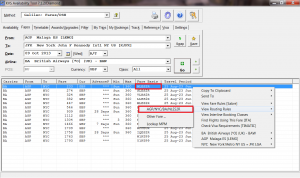
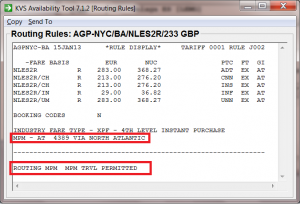
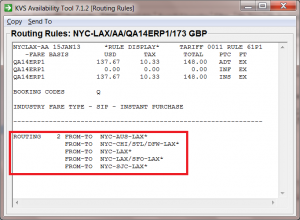
this route via the Atlantic Ocean.Here is an example of a routed fare instead of an MPM fare. The routing rules for this JFK-LAX fare shows the permissible stops. If your rules look like this then you will have to find a different fare.
Step two: Find your TPM
You can easily find your TPM using GCmap.com and typing in “XXX-YYY” where you substitute XXX with the 3-character airport code of your origin and likewise for YYY with the airport code of your destination. For this example I have used Malaga and New York which was mentioned in my introduction. By typing in “AGP-JFK” I can see the actual distance (in nautical miles) between the two cities. This is my TPM — 3658 miles.
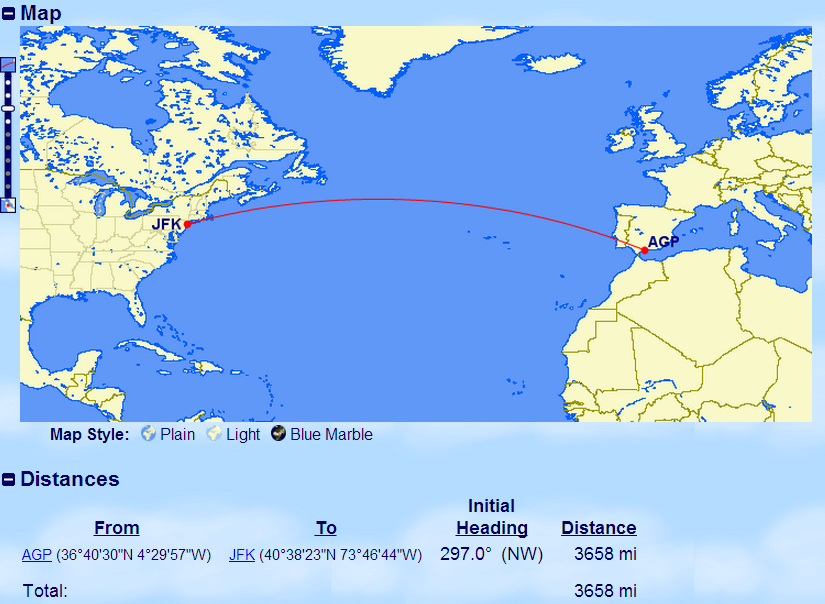 AGP-JFK distance calculated using GCMap. The TPM is displayed under “Distance”
AGP-JFK distance calculated using GCMap. The TPM is displayed under “Distance”
Step Three: Find your MPM
This part is even easier. Take your TPM and multiply by 1.2. For my AGP-JFK example my MPM will be
3658 x 1.2 = 4389 miles.
(Incidentally 4389 miles is the same as what we saw in the example in step one. However, don't be alarmed if it's a little bit out – so long as it's within around 0.5% then you're okay.)
Step Four: Find out the Fare Rules
(If you're not familiar with Matrix ITA I also suggest reading my beginners' guide. This post will cover what you need for this particular trick though.)
So we have now found the MPM, we are ready to add connecting flights to bring our total distance travelled as close to MPM as possible. To do that you need to check the fare rules to see if adding transfers/stopovers are allowed. To do this let's load Matrix ITA and type your start and end airports. Let's have a look at AGP-JFK round trip (r/t) issued on British Airways.
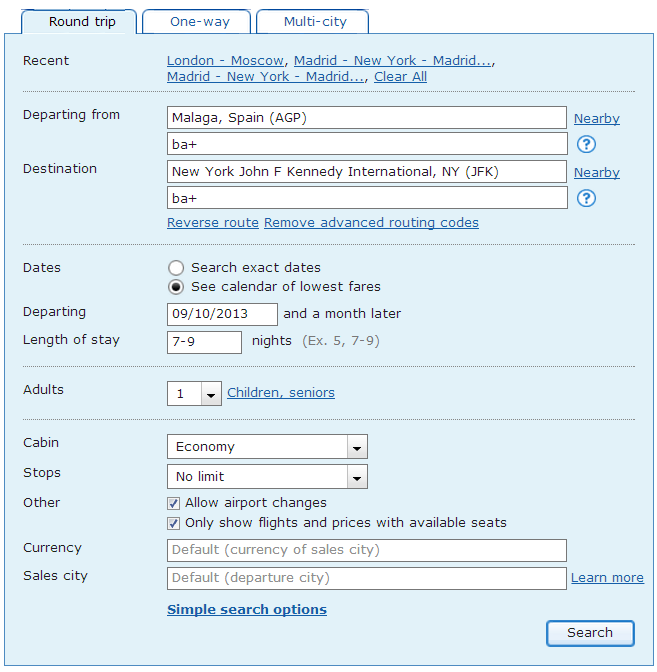
Search page for AGP-JFK with the advanced routing code “ba+”. this “ba” forces the search engine to only look for British Airways coded flights, and the “+” allows for connections.
On the next page you should see either a calendar of prices, or a list of prices depending on how you specified your dates. If you see the calendar now, the list will be the following page.
Click on a price that appeals to you and have a look at the full breakdown of the cost. This will include your fare basis, a link to the fare rules and the base fare cost, which I have highlighted in red below:
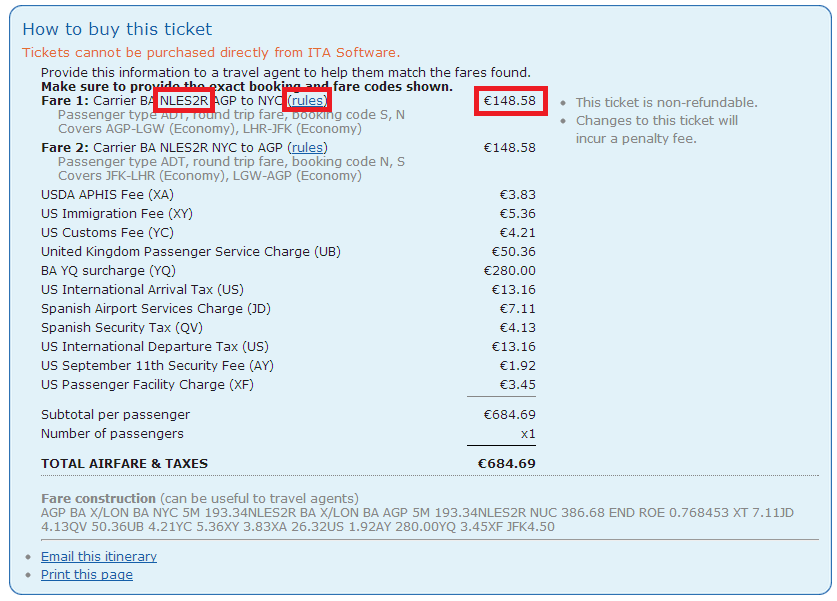
Click on the “rules” link to bring up the fare rules. For this part wording is somewhat free and almost every fare will be different so there's no “one size fits all” measure here. You need to read through the rules carefully.However, here's a checklist for things you should look out for – names and terminology may (but rarely) vary between airlines:
- “Seasonal Restrictions” – is the fare available for the dates you want to fly? Usually the answer will be yes because Matrix will not show it otherwise!
- “Flight Restrictions” – What airlines and flight numbers are permitted/prohibited in the fare?
- “Transfer Restrictions” – The most important of all. How many transfers are allowed? Where can/must you transfer? Between what airlines? How does this fit into the flight restrictions above? If it allow “unlimited transfers” bear in mind the maximum segments per ticket is actually 16.
- “Stopover Restrictions” – Are you allowed to build stopovers into the ticket? How many? At what cost? Will it trigger a Higher Intermediate Point? (I'll explain HIP this in another post)
- “Sales Restrictions” – On which airline(s) must this fare be ticketed? Can you buy it from a travel agent?
Step Five: Create your own new route!
Now the fun part. The goal is to get as close as possible to the MPM as found earlier. You may even exceed the MPM but by no more than 25%. You must also satisfy ALL the fare rules. You might need to swot up on an airline's partnerships and routes (hint: use airline alliances or joint ventures, such as the one between British Airways, Iberia and American Airlines for maximum effect), Google Maps might help for ideas of large cities to fly through and Wikipedia for the airport codes.
You can use GCMap to search for the combined path length of your new route. For my AGP-JFK fare example. I found route Using GCMap I routed AGP-MAD-LHR-IAD-YYZ-JFK (take a look at the search box from the link to the left for how I typed in that route) which comes at 13.1% above the MPM, and I know has flights between each city specified.
Depending on your routing, you may have to pay a surcharge to your base fare. If you exceed the MPM by:
- 0-5%, then multiply your original base fare by 1.05,
- 5-10% then multiply your original base fare by 1.10,
- 10-15% then multiply your original base fare by 1.15,
- 15-20% then multiply your original base fare by 1.20,
- 20-25% then multiply your original base fare by 1.25.
Step Six: Check if your new route is valid
Plug your new route into Matrix ITA using the 3-character airport codes of your routing:
Click through and hope it pulls up a same/similar priced fare as what you found in step four. (It should do if you have satisfied the fare rules and is an MPM routed fare). If it doesn't then one of the following has happened:
- It wasn't an MPM routed fare to begin with. (This might be the case if you weren't able to verify using step one).
- You broke the fare rules. Check your details carefully against the fare rules again, especially regarding number of transfers, which airlines you can transfer from/to and in what regions those transfers can occur.
- There isn't fare availability for ALL your flights on your specified day(s). This is somewhat unlikely if you've chosen the same day as step four.
Of course, it's not easy to tell which of the above it is, especially if you weren't able to check if it's an MPM rule in step one. If you need help, please contact me and I can try to point you towards the solution.
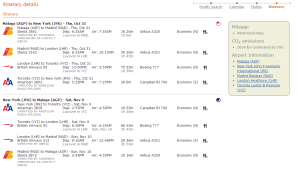
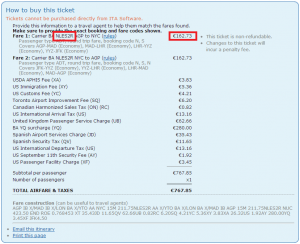
Step Seven: Book it!
So with a full itinerary and price list, now you just need to book it. Some airlines' online reservation systems might only allow for a maximum of 6-8 flight sectors. Check to see if you will be able to book it online. If you can't then call the airline's reservation hotline or a travel agent who will issue you a ticket. Don't be surprised if they sound puzzled as to why you're doing it. Just say you want the extra air miles. The quoted price may be some pennies or pounds either side due to foreign currency conversions but it shouldn't deviate too much from what you saw in Matrix. You may also have to pay an offline ticketing charge for the telephone agent's services but you can usually convince them to waive it if the ticket cannot be bought online. E.g. too many segments to use the “multi-city” search boxes.
That's it! Enjoy your ticket with the satisfaction of pulling off an advanced ticketing technique. Who knows, this extra piece of knowledge might help you in your next mileage run!
Epilogue:
Now the real question. Why would someone go through all this trouble? Well as airlines are shifting the majority of the ticket's price into fuel surcharges and other fees, the base fares are going down. The more they do this the cheaper it will be to add in a few thousand miles of flying. So to maximise this strategy you need to pick two airports as far apart as possible, and a base fare which is as low as possible. I see working the MPM ticketing trick as rough justice for airlines who add on (in my view, punitive) enormous “fuel surcharges”, when in my view they should have been part of the fare all along.
As of writing there are ?145 base fares between JER-LAX, which on its 11,004 mile round trip you can add an extra 3300 miles at a cost of ?36.25 + taxes (probably not a lot!). Those extra miles really add up. Also don't forget some elite status programmes give a minimum mileage for very short sectors.
Conclusion:
I hope you enjoyed this tutorial. If at first you don't succeed, try try again! It can be a little frustrating for beginners of this technique at first, especially when it comes to finding a valid routing, but it will reap its rewards when you get those miles rolling in. Happy flying!

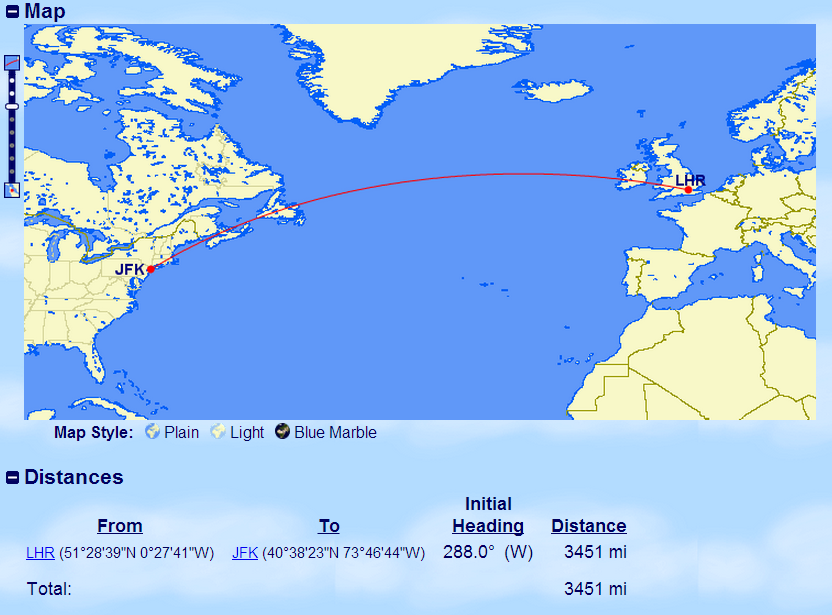
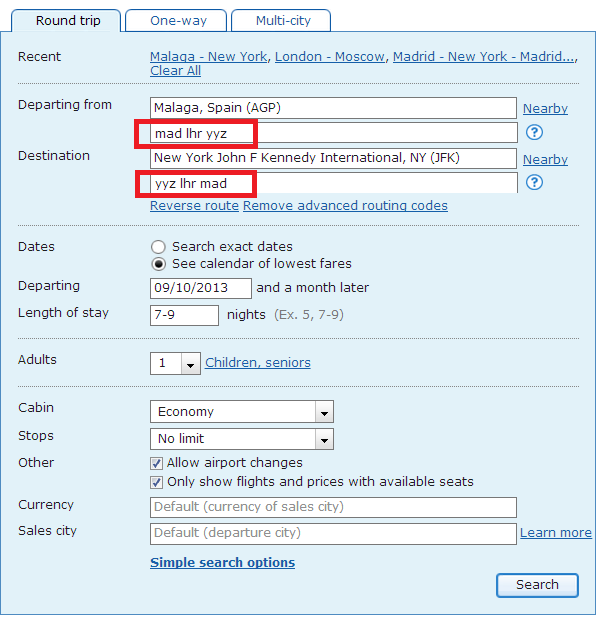
You don’t need EF to find out if it’s a route or mileage fare. If you search on matrix and look at the fare construction, it will contain an “M” if it’s a mileage-based fare. If you exceed MPM it will contain 5M, 10M, 15M, 20M or 25M depending on the percentage you exceeded it by. Also, you might see E/CHI which gives an extra mileage allowance, typically for transiting via one of an airline’s hub airports.
I didn’t know this — you have made me a wiser person! Thanks for the tip, I’ll update the page a bit later to reflect this.
Your comment also explains my pricing discrepancy. My example routing was already at 5M rather than within MPM, so the additional cost will be smaller!
Cool. Glad I could help. Very nice blog.
Cool. Glad I could help. Very nice blog.